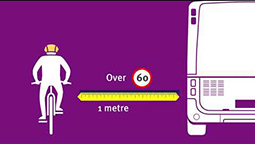Wider of the rider
Cyclists have less protection than other motorists and are more likely to be injured in the event of a crash. This rule better protects cyclists from the risks of a crash when they are being passed by a motor vehicle. Leaving a safe passing distance better protects cyclists, particularly in situations when they may not realise a vehicle is approaching them from behind.
The rule is intended to improve safety by providing more space for everyone – particularly in the event a cyclist has to move suddenly to avoid a hazard. Most states and territories have implemented, or are trialling, this road rule.
What are the key features of the rule?
When passing a cyclist, motorists must leave a minimum passing distance of:
- one metre when passing a cyclists in a 60km/h or less speed zone
- or one and a half metres when the speed limit is over 60km/h.
These rules only apply in situations where the motorist and the cyclist or cyclists are travelling in the same direction. This includes when you are travelling side-by-side in separate lanes on a multi-lane road. It does not apply if you are travelling in opposite directions.
The new road rules apply to all motor vehicles including:
- cars
- motorcyclists
- heavy vehicles
- public transport vehicles.
If a safe distance is not provided, Police can charge motorists with a number of existing road traffic offences including overtaking a vehicle without leaving a sufficient distance.
How is the passing distance measured?
The safe passing distance is measured from the furthest point to the left on the driver’s vehicle to the furthest point to the right on the bicycle.
For the purposes of the rule, cyclists themselves, bicycle trailers, any passengers on the bike or bicycle trailer, as well as baskets and pannier bags are considered part of the bicycle. A flag or stick attached to a bike sideways and extending out from the bicycle or bicycle trailer is not considered part of the bike.
When two cyclists are riding side by side, the distance is measured from the furthest point on the right of the bicycle on the right-hand side of the pair of riders.
Can I cross centre lines when I am driving to pass a cyclist?
To help motorists to comply with these rules, some exemptions to the road rules apply, such as being allowed to cross centre lines when completing the manoeuvre. These exemptions only apply if the driver has a clear view of any approaching traffic and it is safe to pass the cyclist.
When motorists are passing a cyclist and only when it is safe to do so, they are permitted to:
- straddle lanes or move across lanes
- drive to the right of the centre of the road
- cross over or drive to the right of the dividing line, including double solid lines
- drive on or over continuous lines around a painted island
- drive on a dividing strip that is at the same level as the road.
What do cyclists need to do?
To keep safe, cyclists should obey all road rules, including wear a helmet and ride with lights at night. Just like motorists, they also need to stop at stop signs and traffic lights, ride on the left side of the road and give way to pedestrians on crossings and at intersections.
They should also ride predictably in a straight line and signal their intention to turn or change lanes.
For more information on bicycle safety go to the Northern Territory Government website.
